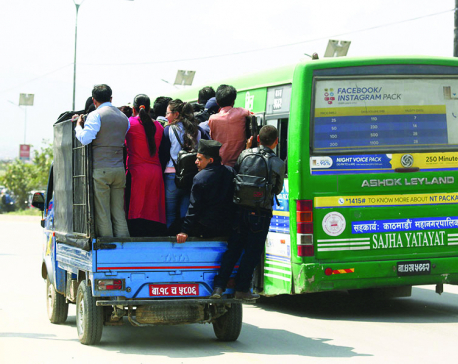
OR
Govt fails to adopt podway technology despite its potential in Nepal
Published On: April 16, 2024 06:10 PM NPT By: Hari Prasad Sharma

KATHMANDU, April 16: The government has not adequately discussed the ‘podway’ technology, which has emerged as an alternative mode of transportation in developed countries, in Nepal. The policy arrangements and studies to introduce podway technology, considered suitable for making pollution-free, fast, and congestion-free public transport, have not been made.
Podway is an innovative transportation system that operates on electricity and travels along suspended wires, controlled by computerized systems. These vehicles can operate at heights of around 30 meters above the road level and require stations resembling sky bridges for passenger boarding and disembarkation.
Although podway technology would be appropriate for both Kathmandu Valley and other areas across Nepal, the government has failed to initiate policy arrangements or conduct studies. The private sector has conducted a study on this technology and submitted a report, but the government has not paid attention to it or taken any initiative to study it.
According to the Nepal Government (Work Division) Regulation-2074, Schedule-2 Serial No. 10 under Item No. 16 under the Ministry of Physical Infrastructure and Transport (MoPIT), the government is mandated to identify and study new technology related to alternative transportation including podway, sky rail, sky trolley water route, amending the previous provision on November 13, 2023. However, despite legal provisions, the government has not yet identified or studied the podway technology.
A podway is a modern mode of transportation where a vehicle hangs a pod (box) on a wire above the road. This technology, which originated in Belarus, has now expanded to several countries including Dubai, and is being studied in India.
Kathmandu Podway Company established four years ago by the private sector in Nepal has conducted a pre-feasibility study for operating a podway in a 100 km area within the Kathmandu Valley.
According to the company’s study for constructing the technology to European standards, building a podway per kilometer is estimated to cost Rs 400 million.
The study suggests that during peak hours, 1,705 pods can be accommodated with each pod capable of carrying 14 passengers, serving 50,000 passengers per hour.
According to the study, the vice chairman of Kathmandu Podway Company, Nil Bhattarai stated that the government has not made the necessary policies and procedures to expand this technology.
“The government first had to identify this technology and conduct study itself,” he said, “If the government experiences the need for this technology, it should make it easier by making clear policy arrangements and procedures.”
The study report emphasizes that the podway technology could be extended to connect different municipalities within the Kathmandu Valley and other provinces. According to this, the technology can be extended to Kathmandu ring road from Kaushaltar-Naikap, Budhanilkantha-Kirtipur, Tarakeshwar-Tokha, Ratnapark-Baneshwar, Gokarneshwar-Bouddha-Arubari-Dakshindhoka.
Similarly, Bhattarai said that pre-feasibility studies have been conducted for operating podway in various areas outside the valley, with study reports submitted to the respective provincial governments.
Similarly, a study has been done to expand the technology to 83 km through Jogbani-Dharan-Chatara in Koshi Province, while a study has been conducted to extend the podway technology to about 6 km in Lumbini Province and the study report has been submitted to the provincial government.
Along with public transport, this technology is also used in goods transportation and cargo services in developed countries. This technology is equally suitable in Nepal in terms of the transportation of goods along with the movement of passengers.
According to Bhattarai, the study showed that if this technology is adopted only for the transportation of goods from Birgunj to Chobhar dry port, the cost of transportation will be reduced and it will also contribute to the economy.
According to the MoPIT, the expansion of the podway technology has not progressed as expected since it is the latest alternative transport, it requires more investment and the technology has to be imported from outside. However, the MoPIT has stated that it is working on addressing policy issues to facilitate the expansion of the podway technology.
Transport expert Ashish Gajurel mentioned the importance of government intervention in identifying and studying this technology to determine whether it is necessary. Various studies have shown that this technology is suitable for areas including forests and parks, high mountains, and the Himalayan region.
You May Like This

Trail Race Series: Creating the foundation of sports tourism
Technology has travelled a milestone resulting in easy accessibility and better transportation facilities. One can reach every corners of the... Read More...

Say no to syndicate
The decision to end syndicate was right and just but the government did not have a concrete plan to implement... Read More...











Just In
- Nepal at high risk of Chandipura virus
- Japanese envoy calls on Minister Bhattarai, discusses further enhancing exchange through education between Japan and Nepal
- Heavy rainfall likely in Bagmati and Sudurpaschim provinces
- Bangladesh protest leaders taken from hospital by police
- Challenges Confronting the New Coalition
- NRB introduces cautiously flexible measures to address ongoing slowdown in various economic sectors
- Forced Covid-19 cremations: is it too late for redemption?
- NRB to provide collateral-free loans to foreign employment seekers







Leave A Comment